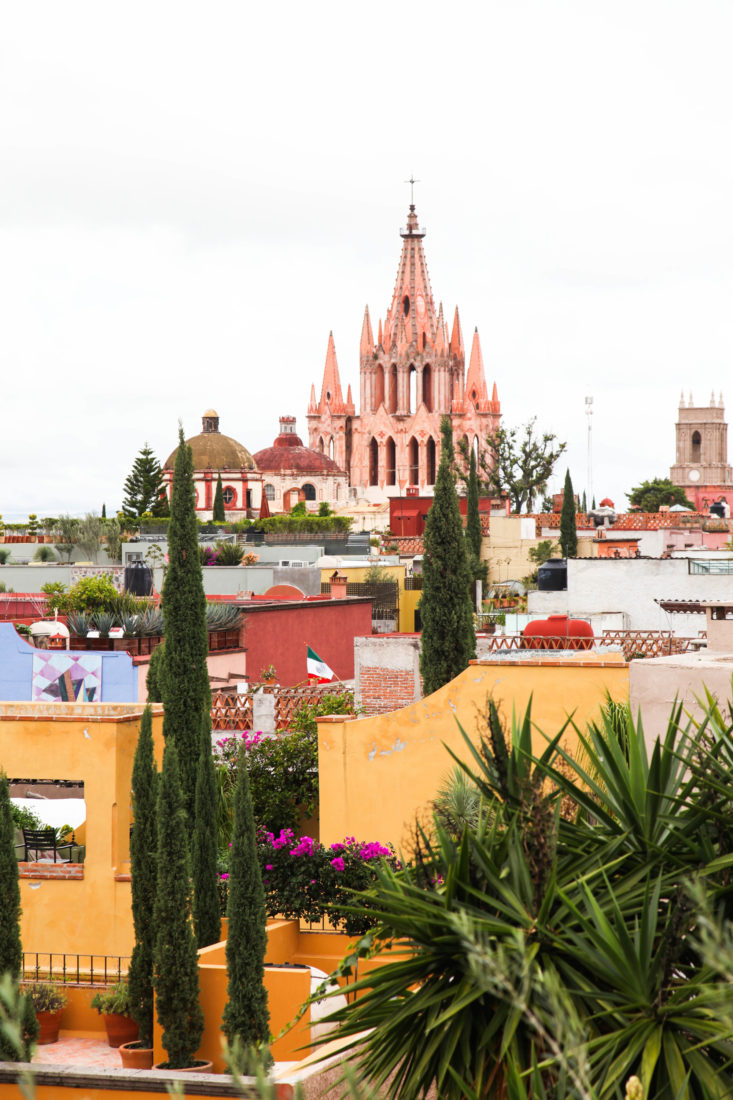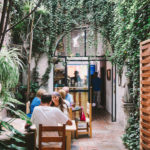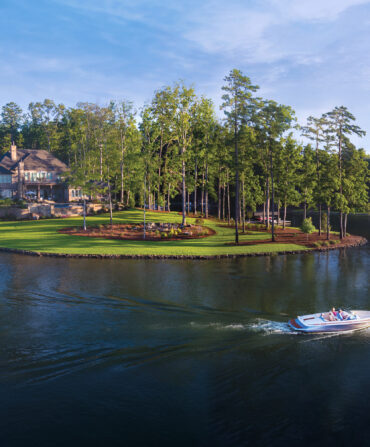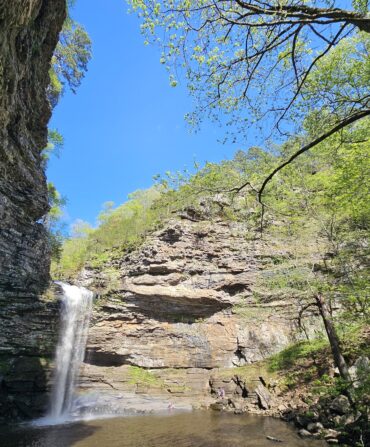“Do you have an old sweater?” my host, Andrew Fisher, asks.
An old sweater? I’ve just dropped my bags and changed into a crisp blue button-down for dinner.
“I’d hate for you to burn your shirt,” he says, leaving me even more confused.
We’re sipping tequila in the loggia of Fisher’s historic walled house in San Miguel de Allende, Mexico. Three years ago, Fisher and his husband, Jeffry Weisman, visited San Miguel and, like many fellow Americans—a large percentage of whom hail from the South—fell under the city’s spell. The pair, owners of Fisher Weisman Design and Decoration, came as tourists, but within hours of arriving decided to buy this house, dubbed Casa Acanto, after the acanthus leaf. They’re among the approximately 8,000 Americans living in this city of 140,000. Though Weisman’s away, we’re accompanied by their good friend and fellow expat Lisa Coleman. She and her husband weren’t nearly as impulsive as Fisher and Weisman. During a family vacation to San Miguel twelve years ago, they waited a whole eight days before falling for a house.
Halfway through my second tequila, I learn how it is I might get burned. I’ve arrived in San Miguel, a picturesque mountain town 170 miles northwest of Mexico City, on the country’s Fourth of July: September 16. San Miguel is the cradle of Mexican independence, the place where, in 1810, insurgents first plotted the end of Spanish colonial rule. Tonight, there will be fireworks in the main plaza, known locally as El Jardín. Every year, Fisher says, at least one rocket spins out of control and scatters spectators like the bulls in Pamplona.

Photo: Amy Dickerson
The pool at Casa Acanto.
At dinner, in the courtyard of a restaurant called Chamonix, a few blocks from El Jardín, I’m halfway through a filet mignon when an explosion rattles our water glasses. The night sky flashes gold. Fisher calls for the check. Famished from my travels, I shove steak into my mouth. Another boom. “Come on,” he says. “Chew! Chew! Chew!”

Photo: Amy Dickerson
Fiesta flags wave above a side street.
In the plaza, the throng presses in on three towering bamboo-and-wire frames—castillos, Fisher calls them—with hand-tied fireworks mounted on their rickety crosspieces and struts. “Closer!” Fisher urges. We squeeze past children and grandmothers, looking up just as three massive pinwheels sputter to life. Spinning faster and faster, brighter and brighter, the wheels whistle like demons while raining fiery embers down on the cheering crowd.
I’m finding it easy to get swept up in the excitement of San Miguel de Allende. Before my trip, I didn’t know a soul here. But Katharine Hibberts, an Alabama native who runs a house rental and concierge service called Premier San Miguel, opened doors. That’s what she does. And San Miguel has some fabulous doors.

Photo: Amy Dickerson
Carved wooden doors line the historic streets.
Among Americans, the city is most famous for two things—its thriving expat community and its storybook homes, many of which are rentable. Most houses, especially in the historic city center, don’t look like much from the narrow, cobbled streets—just a high wall and a rustic wooden door. That’s what I found when my driver dropped me in front of Casa Acanto. Then the door creaked open, and I stepped into Shangri-la.
Enclosed within four towering, vine-covered walls and shaded by a feathery canopy of jacaranda trees, the colonial-era property is one of dozens of houses Hibberts offers her clients. Inside that secluded space, house and garden are locked in a loving embrace. High-ceilinged, art-filled rooms spill onto loggias, bedrooms onto leafy terraces. San Miguel’s perennial springlike weather makes this indoor-outdoor living possible.

Photo: Amy Dickerson
Cobblestoned streets and high walls in bright hues are typical in historic San Miguel.
Hibberts up and moved here from Nashville in 2003, inspired by her mother, Nancy Howze, who left Birmingham and resettled here permanently in 1998 after Hibberts and her brother had flown the nest. Single and fifty-one years old at the time, Howze says, “When I first arrived, I saw all these people twenty and twenty-five years older than me skipping around town having drinks and going to parties. I didn’t see seventy-five-year-olds skipping around Birmingham.”
That night, after the fireworks and a nightcap at a candlelit rooftop bar called La Azotea, I climb stairs to the rooftop terrace of my casita at Casa Acanto and gaze at the Gothic spire of the Parroquia, San Miguel’s main church, glowing above the glittering colonial city. The air is desert clear. A warm breeze rustles the jacaranda leaves. I feel a tremor of desire, and my mind starts playing out house-buying scenarios. That’s when I know it’s time for bed.
The original San Miguel expat was the late Stirling Dickinson. In 1937, the diffident twenty-seven-year-old Chicago trust funder—a Princeton graduate who also studied at the L’Ecole d’art Américaine at Fontainebleau near Paris—booked a train ticket to San Miguel. Upon arrival, he took one look around and, you guessed it, stayed. Dickinson was something of a visionary. The former mining outpost was nearly a ghost town. By 1900, the silver had dried up and the population was moving on; by the 1920s, after a decade of bitter civil war, fewer than seven thousand called San Miguel home. Dickinson moved into an abandoned stone tannery and became director of the Escuela Universitaria de Bellas Artes, San Miguel’s first art school. During World War II, Dickinson served as an intelligence officer in Washington and Italy, but he returned to San Miguel in 1945 and laid the groundwork for its comeback as a magnet for artists and American expats. His secret? The Servicemen’s Readjustment Act, better known as the G.I. Bill. So many veterans signed up for art school in San Miguel that in 1948 Life magazine called the city a “G.I. Paradise.” Before he retired, in 1983, Dickinson had helped bring some forty thousand American students to San Miguel, many of whom chose to stay.
If Dickinson inspired waves of expat artists, a Fort Worth art patron named Martha Hyder did the same for Texans. In 1959, she and her now late husband, Elton, bought a sprawling walled home a few blocks south of the main plaza, where Martha became famous for her lively house parties and deliciously unhurried, salon-style luncheons. Thanks to the Hyders, folks from Dallas–Fort Worth started coming to San Miguel, followed by Houstonians and Austinites. The border is twelve hours away by car, but today, with direct flights from a number of Southern cities, getting here is easier than ever. During my visit, I meet lots of Southerners—folks from Alabama, Tennessee, North Carolina, and Georgia. And, of course, plenty of Texans. They come for the three-hundred-year-old houses, market stalls full of produce and flowers, and a culture that favors long lunches and afternoon naps. San Miguel is like Provence without the jet lag, and with prices in pesos, not euros.

Photo: Amy Dickerson
Bougainvillea climbs the wall of a private residence.
Walking is the best way to soak up San Miguel’s charms. Under the Mexican sun, the city explodes with color—a range of earthy ochers, the rosy hues of cantera (a local volcanic stone), bursts of fuchsia bougainvillea. It’s a painter’s city, if there ever was one. I poke my head into art galleries carved out of the grand historic homes and find the mother lode at the Fábrica la Aurora art and design center, a former turn-of-the-century textile factory filled with galleries and working studios. There, and inside both the Bellas Artes and the Instituto Allende, the other cultural center Dickinson directed, I find bulletin boards shaggy with flyers for exhibits, art classes, and cooking lessons.
The culinary-arts scene is a more recent San Miguel phenomenon. Instructors often begin class inside the labyrinthine daily market near El Jardín or at the massive Tuesday market, El Tianguis, just outside the historic center, filling baskets full of nopals (cactus paddles), fresh and dried chiles, mangoes, and passion-fruit-like granadas chinas. Local chefs take advantage of the abundance, too. There are countless cafés and restaurants in town, but sitting atop the food chain is American expat Donnie Masterton, chef and owner of the Restaurant. Masterton worked in Washington, D.C., and Beverly Hills, and ran his own eatery in San Francisco before leaving the rat race in 2005 to serve his global comfort food here.

Photo: Amy Dickerson
California native chef Donnie Masterton helms the kitchen at the Restaurant.
More and more of that local bounty is organic. Leading the charge is a nonprofit organization called Vía Orgánica, which operates a farm outside San Miguel and a retail store, restaurant, and training center in town. One morning, Lisa Coleman’s twenty-six-year-old son, Charlie, and his friend, Vía Orgánica program director and Dallas native Griffin Klement, invite me for a farm tour and a horseback ride. The two are part of a new wave of younger expats—chefs, DJs, artists—migrating to San Miguel.

Photo: Amy Dickerson
Annie Coleman models one of her family’s serapes from Recreo.
Vía Orgánica’s farm manager, Humberto Fossi—sporting a goatee and a faded Jimi Hendrix T-shirt—leads the trail ride. He’s taking us into the hills to visit Doña Beatriz, who bottles his favorite pulque, a frothy fermented beverage made from the sweet fluid tapped from giant agave plants.
We cross grasslands filled with blooming cosmos, black-eyed Susans, and a color wheel of wildflowers I’ll never identify. As we climb, our perspective broadens. Below, an ancient hacienda slowly crumbles beside a shallow lake. We clop along weedy cobbled roads, no signs of vehicles anywhere.

Photo: Amy Dickerson
Humberto Fossi, Azucena Cabrera, and Griffin Klement of Vía Orgánica.
After an hour in the saddle, we dismount in Lagunilla, a tiny hillside village with a grassy courtyard, a stone church, a schoolhouse, and scattered houses. Doña Beatriz, a short, stout woman with a black apron and black hair pulled back from her face, welcomes us to her low-slung dwelling, seating us out back beneath a vine-choked arbor. Fossi pours everyone a glass of the fizzy yellow liquid. It’s cool, tart, sweet, and refreshing, like cider made with honey instead of apples. The food starts to arrive: quesadillas made with purple-corn tortillas, beans, squash blossoms, and stringy goat cheese; a grapefruit-size zucchini halved and stuffed with cheese and tomato and served over rice; and a tomato-based soup with the tender, mild meat of a giant white puffball mushroom.
Back in San Miguel, feeling rejuvenated by the return ride (or maybe the pulque), I dress for yet another social engagement. (Since I arrived, Lisa has arranged drinks and tours in the homes of several gracious Texans.) The finale is a grand soiree hosted by a French couple who divide their time among here, New York, and Paris. I arrive at the address and once again find myself standing on a cobbled street before a windowless wall and a heavy wooden door. From within, faint laughter. Having experienced the wonders of Casa Acanto, I can only imagine what awaits on the other side.











